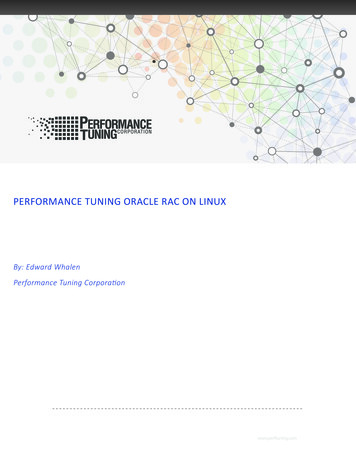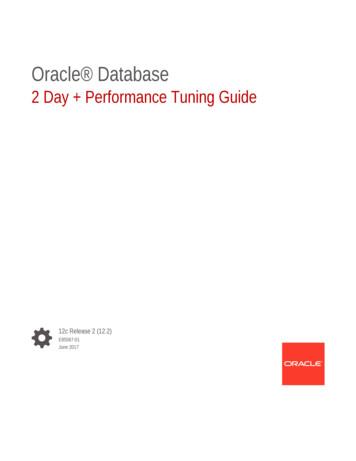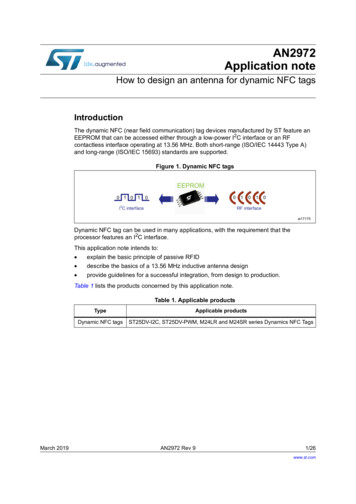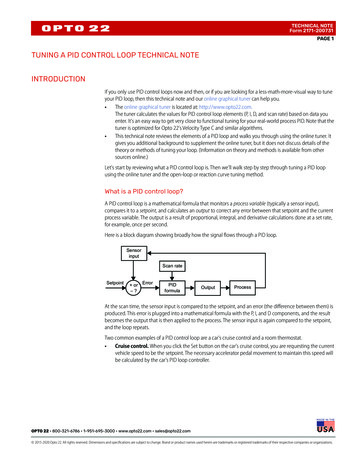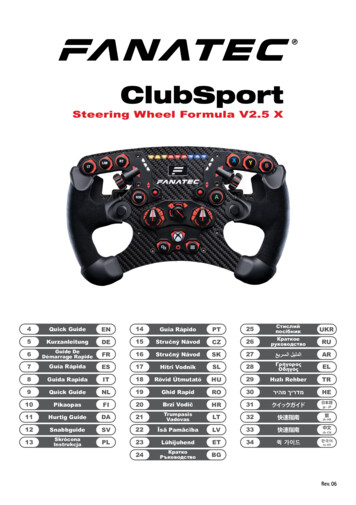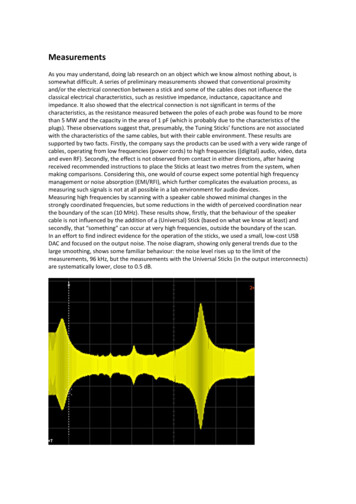
Transcription
MeasurementsAs you may understand, doing lab research on an object which we know almost nothing about, issomewhat difficult. A series of preliminary measurements showed that conventional proximityand/or the electrical connection between a stick and some of the cables does not influence theclassical electrical characteristics, such as resistive impedance, inductance, capacitance andimpedance. It also showed that the electrical connection is not significant in terms of thecharacteristics, as the resistance measured between the poles of each probe was found to be morethan 5 MW and the capacity in the area of 1 pF (which is probably due to the characteristics of theplugs). These observations suggest that, presumably, the Tuning Sticks’ functions are not associatedwith the characteristics of the same cables, but with their cable environment. These results aresupported by two facts. Firstly, the company says the products can be used with a very wide range ofcables, operating from low frequencies (power cords) to high frequencies ((digital) audio, video, dataand even RF). Secondly, the effect is not observed from contact in either directions, after havingreceived recommended instructions to place the Sticks at least two metres from the system, whenmaking comparisons. Considering this, one would of course expect some potential high frequencymanagement or noise absorption (EMI/RFI), which further complicates the evaluation process, asmeasuring such signals is not at all possible in a lab environment for audio devices.Measuring high frequencies by scanning with a speaker cable showed minimal changes in thestrongly coordinated frequencies, but some reductions in the width of perceived coordination nearthe boundary of the scan (10 MHz). These results show, firstly, that the behaviour of the speakercable is not influenced by the addition of a (Universal) Stick (based on what we know at least) andsecondly, that “something” can occur at very high frequencies, outside the boundary of the scan.In an effort to find indirect evidence for the operation of the sticks, we used a small, low-cost USBDAC and focused on the output noise. The noise diagram, showing only general trends due to thelarge smoothing, shows some familiar behaviour: the noise level rises up to the limit of themeasurements, 96 kHz, but the measurements with the Universal Sticks (in the output interconnects)are systematically lower, close to 0.5 dB.
High scanning frequencies (100 kHz-10 MHz). Speaker cable with Universal Tuning Stick. Load 0.047 mF/5 h, inputimpedance 0.20 Oh, signal 50mVrms width. Horizontal resolution 2mS/DIV.Range noise at output d/a converter. Sample rate 24/96. With two Universal Tuning Sticks on line outputs (green curve),without Tuning Sticks (red).The analysis of this noise spectrum gives indications that this particular stick indeed acts in manyplaces, ranging from low to high frequencies, though only in a small rate. The diagrams are calibratedwith μV to give a sense of scale sizes involved. A spectrum analysis, this time with the E-Gold TuningmkII placed on the power cable, shows even better results, giving the impression that this “big” Stickis clearly more effective when compared to the Universal (or more probable: that this seriousproblem in the converter found a bit of power and noise rejection).
Noise analysis (wideband) in d/a converter output. input signal 1 kHz (24/96, filter rejection band measurement). Noisewithout Tuning Sticks (blue graph) and Universal (orange).Noise analysis (wideband) in d/a converter output. input signal 1 kHz (24/96, filter rejection band measurement). Noisewithout Tuning Sticks (blue graph) and with E-Gold Tuning mkII (red).This trend continues when using more and more of the complete Akiko set. The relevant figurecomes from placing a Universal Stick on the S/PDIF, two RCA Sticks on the line outputs and an E-GoldTuning mkII on the power cable and appears to confirm Akiko Audio’s claim that the Sticks have a
cumulative effect. The standard configuration of the measurement signal for (wideband) noise thateach DAC makes, also shows the rendering improving with each Stick.Noise analysis (wideband) in d/a converter output. input signal 1 kHz (24/96, filter rejection band measurement). Noisewithout Tuning Sticks (blue graph) and with full Tuning Pack Sticks (Universal, RCA and E-Tuning Gold mkII, green).Signal from noise modulation (wideband) in d/a converter badge 24 kHz, without Tuning Sticks (blue graph) and with fullPack (green).
After all that, one can indeed argue there is a measurable impact the Sticks have on the noise of asystem in the high frequency areas (even in the acoustics range). An even better approach, ratherthan looking at the effect itself in the images we’ve seen up to this point, is to look at the results ofthe actual impact of the Sticks themselves in the much higher frequency range (in the order of tensof MHz) and indeed, an analysis of the spectrum in this region shows this effect. When studying therelevant diagrams (derived from data domain acquisition by Cadence in 100MSa mixed with 512xaveraging, for those who like the details) one should keep in mind that we are dealing with the, forthis report, unusual 0-50 MHz range, which means the usual area of interest (up to about 100 kHz fordigital systems) is cramped into the part on the left and thus almost unseen. The cutting edge thatonce distinguished the 24 kHz signal is applied to the converter. According to both the existence of asmaller number of components and also the comparison between components that exist in bothcases, the system generally displays less noise with Sticks in place. This comparison most oftenresults in favour of the version including the Sticks. Also quite interesting is the fact that the noisecomponents seem to decline in frequency, at least up to the limit of 50 MHz, in the case with Sticks.This probably shows how Akiko’s effect is more important in the higher frequency range (although,alternatively, it could be that the range is digressive in general and in two cases or even be periodic;we cannot know for sure). How important these findings are, or to what extent we can associate thebest behaviour of EMI/RFI issues that the system with Stick seems to have with any sonic differences,is not certain. This because in addition to and in compliance with standard specifications theredoesn’t seem to have been any study (which associates sound quality with EMI/RFI noise levels) and,of course, the measurement of a component and usage scenario doesn’t provide enough evidence inany case. In the first instance, however, the fact that the use of Sticks leads to smaller noise levelsoutside of the measurable impact band and less noise within, should suffice. The whole experimentdoes need to be investigated wider though.Noise spectrum analysis (0-50 MHz) without Tuning Sticks. Sampling, averaging 100MSa 512 x.
Noise spectrum analysis (0-50 MHz) with full Tuning Pack Sticks. Sampling, averaging 100MSa 512 x.Impressions and conclusionsAcoustic assessment of the Tuning Sticks’ effect consisted of two phases. First of all the effect on thereference system sound using a pair of Universal Sticks, which were placed on the speaker cables toestimate the change caused when compared to a full package (consisting of a pair of Universal(placed similarly), RCA and E-Tuning Gold mkII Sticks (placed on both power lines of the finalreference amplifier)). The reference system that was used in almost all of the tests came fromavmentor.gr and consisted of a Teac Esoteric D70/P70 (configured for 4 x upsampling dual link cableswith the Nirvana AES3 DC-110), the Melos preamp Plus Series Line, Parasound HCA3500 and ATCSCM-50PSL speakers. Using the Tuning Sticks couldn’t be simpler: just put them where they need tobe and, if mechanical support on the cable is needed, use the accompanying Velcro strips. The initialimpression you get when you hear the system with Tuning Sticks in place is that there is, indeed, anaudible difference (depending on the type and value of the system in question). Passers-by reachedthis same conclusion when passing the listening venue and hearing the system with and withoutSticks. Because it is not fully understood how these Sticks operate, it was considered important,before applying the usual evaluation process, to precede with an ABX test to confirm that thesedifferences are real and not some psychoacoustic phenomenon unrelated to our test subjects. Totest this we used the files at the end of this text and the well-known Foobaar2000 plug-in. The scoreproved to be particularly encouraging, as they gave only a 1.1 % error margin, in other words, thelistener achieved a 9 out of 10 score. The test doesn’t have any significant statistical meaning. Itdoes, however, give a serious indication. I recommend readers to do the same tests, using therelated files and using track 4 as a basis, as it is, I my opinion, the most revealing.
Now for the details. What mostly characterises the audible changes, when the Tuning Sticks areplaced, is the significant gain in clarity, the presence and the sense of accuracy. The reference systemis commendable for already having these qualities and for the detailed and textured rendering it isable to generate, Akiko however, wins points by moving each mix’ particular characteristics withgreater comfort and creating the impression that it is more neutral and that they are absent from thesite. Furthermore, the Sticks seemed to make it more homogeneous, gave the area more low andbetter control and gave a commanding sense of when the program included very low frequencies,without standing out and claiming more attention than their fair share. There have been changes inthe high frequency area which, although still retaining the basic characteristics, sounded maybe a bitfriendlier and more pleasant compared to what I am used to. In terms of the tall area, the system didnot show any significant change. Neither did anything seem to change in the tonal balance andneutrality of the system, however there were changes in the dynamic themes. As it stands, thereference system typically manages the dynamic contrast and has the low noise and power marginsneeded to raise a composition with intense vagaries to realistic levels (these hearings were made at aspecific level of listening position with reference to the digital source-20dBFS). Although in myopinion the Tuning Sticks didn’t seem to change anything dramatically, there did seem to be a profitin the very low frequency area, as has been mentioned. What did change was the system’scapabilities to reproduce micro dynamics (instantaneous dynamic range requirements, which relatemainly to the complexion and the timbre of specific musical instruments and general sound eventsthat may exist on a track and kat epilogin, such as the sound of keys on horns). Despite the fact thatthe reference system is very good when it comes to this (I believe the combination of a P70 and D70is one of the best I’ve hear so far, even though its old age), the Tuning Sticks showed there is stillroom for improvement. This cannot be associated with the improvement of the rendering, nor withthe increase in the rendering capabilities of the micro dynamics. The bottom line however, is that thesystem had the ability to transfer more data in this region (or at least transfer it more persuasivelyand more clearly defined), which in itself is impressive, especially given the cost. Does this effectincrease with the amount of Tuning Sticks used? The answer is yes, but certainly not linear. Oneshould not expect similar changes with each stick added, the system simply wins even more witheach Stick in place (as described in the beginning). The most important difference however, wasbetween no Sticks and two Sticks. This observations allows for a response that deals with twoimportant questions: One, what Stick should you use? And two, where should you place it? If theSticks work as assumed then a good place would be the noisy input ports in the system. These maylie in different places, depending on the device and the environment, but are certainly related to thepower cables (perhaps it is no coincidence that the biggest improvement in the measurementsseemed to come from the E-Gold Tuning mkII). It would also not be a bad idea to cut the noise at theend of the system, at the speaker cables (and so perhaps it is no coincidence that we have heard abig difference when using two Universal Sticks there). As in the case of noise concepts however,inducing “before”, “after” and “pluck” is rather too conventional to describe the phenomenon, sotests are required for each case. Thankfully it are such phenomena that make audio such aninteresting area of technology. As simple in construction and use as the Akiko Audio Tuning Sticksare, in proportion to the value of their significant improvement, is a cynic’s proof that research onthese key issues is still far behind, but also a first class opportunity for more fumbling andupgrading that bleed ones wallet dry. Worth a try, in my opinion, especially as the company refundany unsatisfied customers, though I much doubt that is ever needed Dimitris StamatakosThis is the English translation of the original test report:http://avmentor.gr/reviews/akiko tuning sticks 1.htm
cables, operating from low frequencies (power cords) to high frequencies ((digital) audio, video, data and even RF). Secondly, the effect is not observed from contact in either directions, after having received recommended instructions to place the Sticks at least two metres from the system, when making comparisons.
